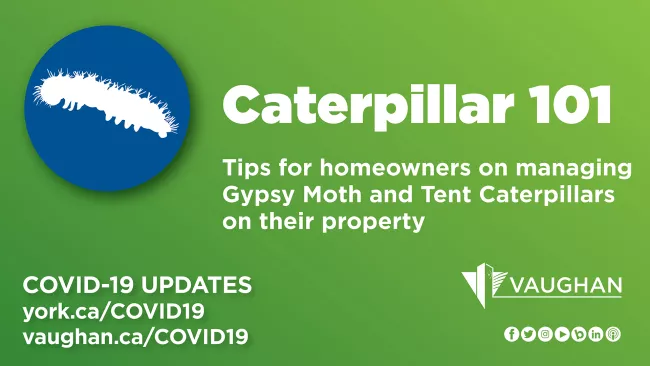Caterpillar 101
This summer, residents may be seeing an unusually high
number of Gypsy Moth and Tent Caterpillars throughout the community. As a
result of weather conditions from the winter and spring months, southern
Ontario is experiencing a peak point in their population cycles. These insects
are naturally occurring forest pests, are not unique to Vaughan and present no
harm to healthy trees.
There are several different types of caterpillars in the
province that feed on the leaves of trees – all with cyclical populations that peak
in intervals. The Gypsy Moth and Tent Caterpillars are usually not a cause for concern
as they peak about every eight to 10 years. Most trees will survive defoliation,
growing a new crop of leaves that same summer. Healthy trees can survive
several years of defoliation. As there have not been consecutive years of high
outbreak levels, the City is not presently treating for these caterpillars. The
City continues to monitor the situation and impact on City trees to determine
if any action is required.
What are Gypsy Moth Caterpillars?
The Gypsy Moth is an insect that was
introduced to Ontario in 1969. This type of caterpillar prefers hardwood trees
such as oaks, maples, birch and aspen. However, during an infestation it may
defoliate any hardwood species. The female adult will lay its eggs on the trunk
of a tree and the eggs will emerge as adults in early to mid-August. The larvae
will eat the leaves but will otherwise not harm the trees. The trees will
usually be able to grow a second crop of leaves the same season. Once
hatched, the caterpillars begin to feed for approximately seven weeks. The
moths are short-lived.
What are Tent Caterpillars?
Tent Caterpillars are the most widespread defoliator (an insect that strips all the leaves from a tree or shrub) of hardwood trees in North America. In southern Ontario, these caterpillars prefer sugar maple and oak, but can also be found defoliating many other hardwoods excluding red maple. Heavy infestation results in reduced tree growth and branch killing. These caterpillar populations fluctuate from year to year, with outbreaks occurring every several years. They are in flight from late June to early August. Eggs are laid in the summer, with the larvae emerging the following spring. Full-grown caterpillars are 50 millimetres long, and, after feeding for six weeks, spin yellowish cocoons in a sheltered place and then transform inside.
What can residents do?
Prevention and early control are important. The removal and destruction of egg masses drastically reduce the presence of caterpillars the following season. Homeowners can:
- pick caterpillars off leaves, tree trunks and branches and soak them in soapy water to destroy them.
- install burlap wraps around tree trunks and then collect and destroy caterpillars and pupae.
- scrape off and destroy egg masses.
Additional resources can be found on the Ministry of Agriculture, Food and Rural Affair’s webpage.
If you have concerns about trees on your property, contact an arborist. For materials and supplies, contact your local nursery or garden supply store.
For more information, visit vaughan.ca/trees.
-30-

